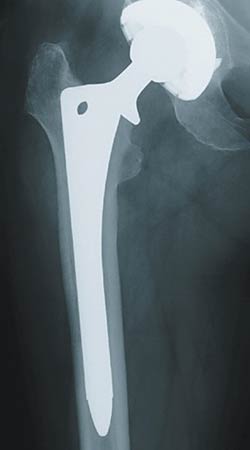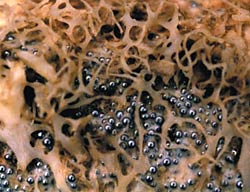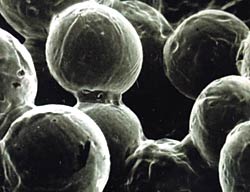Porous ingrowth fixation revolutionized hip replacement
Since its invention in the 1970s, bony ingrowth has replaced much of cemented fixation for hip arthroplasty.
Research physicians invented porous ingrowth fixation for hip arthroplasty in the 1970s as a response to some misunderstandings regarding “cement disease.” Twenty-five years after porous-coated components began to gain popularity, they have slashed overall failure rates and generally revolutionized the field of joint replacement.
“If you want to encompass important aspects of how change takes place in science or anywhere, but specifically in relation to bony ingrowth for total hips, it’s important to understand that progress is not linear,” said William Harris, MD, of Mass General Hospital and Harvard Medical School in Boston. “This is one of those fascinating ideas that worked out really well, but was done for the wrong reason.”
Harris was one of the pioneers of porous-coated technology, and along with Jorge Galante, MD, of Rush University Medical Center, he created one of the most widely used porous-coated implants, the Harris-Galante. Before teaming up with Harris, however, Galante helped invent some of the first types of bony ingrowth with William Rostoker, PhD. They created a fiber mesh to support bone ingrowth and that led to one of the first designs for porous-coated hip components.
“The dramatic success of total hip replacement as introduced by [Sir John] Charnley was such an extraordinary incremental advance in our ability to treat patients with severe arthritis of the hip, that it just blew everything out of the water,” Harris told Orthopedics Today. This dramatic success, however, was soon tempered by worsening results after about 10 years of follow-up.
‘Cement disease’
The components began to loosen with increasing frequency and patients often suffered significant bone loss. “The widespread belief was that this was an adverse reaction to cement,” Harris said. “If that was the case, then was there any other way we could get the components to stay fixed to the skeleton? It was here that the birth of cementless fixation began.”
COURTESY OF DEPUY ORTHOPAEDICS INC. |
While some of the earliest trials for porous-coated implants were what Harris describes as “unmitigated disasters,” the advantages to having a patient’s own bone act as the main means of fixation gradually became clear. Failure rates dropped as loosening of components became less frequent, and patients were given more leeway to be increasingly active without fear of breaking down the cement.
John Collier, DE, a professor of engineering at Dartmouth College, was also involved in some of the early efforts to create porous-coated hip components along with Robert Pilliar, PhD. “The questions that we tried to deal with in the very earliest days included how to make the porous coating strong, how much of the surface should be coated, what size the pores should be and what should the coating be composed of,” Collier said. “Those eventually were dealt with by a lot of animal research and by following the clinical performance carefully.”
Initially some groups attempted to modify the cement and others tried to replace it with porous ingrowth. “My background was as a metallurgist, so I was more interested in how you replace the cement rather than how you improve it,” Collier said. “In fact there were folks from a whole lot of different areas that were looking at different techniques for porous coating.” J. Dennis Bobyn, MD, and Charles A. Engh, MD, were also instrumental in creating and refining porous-coated implants.
Collier’s group at Dartmouth has been running an implant retrieval lab for decades and have studied close to 8000 components. “What you begin to pick up is that the prime criterion for success is that these components must be very well fixed at the time of surgery,” Collier told Orthopedics Today. “If they are really well fixed, they tend to do well with a variety of pore sizes and biocompatible compositions.”
The next major step in porous-coated implants was the implant designed by Harris and Galante (HG1, Zimmer), introduced in 1983. At first it appeared that cementless implants would work for younger patients only, since this group was generally more demanding. Eventually, however, Harris said that it has become clear that they should be the method of choice for virtually every hip arthroplasty patient.
“There are three categories of patients that need an acetabular reconstruction, and if you lump everything together you miss important pieces of information,” Harris said. “There’s the standard older patient who needs a total primary, the younger patient, say 50 years and younger, who needs a primary, and patients who need revisions.”
The early assumption that cementless components would be effective in the young have proven to be overwhelmingly accurate according to long-term data. Acceptance of cementless implants in the older group took longer, largely because patients in this group historically had fared better than most with cement. “It is not as widely accepted just because the evidence is newer, but the evidence is quite clear that in the older age group you should do a cementless socket as well,” Harris said. “At 75 [years old], the average life expectancy in the United States is 14 years. That’s plenty long enough to get lysis.”
Using cementless implants for revision surgeries has also proved very successful. “The revision results are stunning,” Harris said. “They’re not as good as primaries but they are stunning.” Several further innovations in the technology have helped improve the revision results, including the use of jumbo cups that provide more surface area to maximize bone ingrowth, and the high hip center concept. This also helps contend with the loss of bone often seen in revision arthroplasty.
“So the overall picture is that on the acetabular side, for primaries in the young, primaries in the older and revisions, nothing comes close. From our point of view, all sockets should be cementless, except in the very elderly,” Harris said. The choice between cemented and cementless components on the femoral side is somewhat less cut and dry, at least for primary surgeries. “You can go either way on the femoral side in primaries. However, in revisions, cementless wins hands down.”
Even after surgeons began to have significant success with cementless implants on the acetabular side, many failures continued on the femoral side. Subsequent improvements to the femoral components have produced varied designs and good results in many of them. “It is now possible to get excellent long-term results in primary total hip replacement with proximally coated porous implants [on the femoral side],” Harris said. “The strange thing is that the designs vary wildly, and work. So, the initial problems of failure of fixation of the proximally coated femoral implants has been solved.”
Further improvements
The fixation with the Harris-Galante and other cementless implants largely solved the problem of loosening, but it took some improvements to eliminate other causes of failure. Locking mechanisms tended to fail but have since been significantly improved, and bearing surfaces are still being improved today.
|
“If you take out the poor early locking mechanism, and if you take out the lysis which is not a problem of the cementless shell, then the true majesty of the thing becomes apparent,” Harris said. “The figures show that at 10 years and even at 15 years in the neighborhood of 95% of the sockets are solidly fixed.”
Collier agreed that cementless implants have all but eliminated the problem of loosening. “What’s really impressive is the very low incidence of late loosening of well-fixed porous-coated devices,” he said. “They’ve lived up to that part of the expectation. So if you have a loose porous-coated device, it is likely that either it was never well fixed or that you had a big infection. But the idea of bone deciding that it no longer wants to be in the surface or you’ve overloaded it so that the bone goes away seem to be concerns that aren’t manifested.”
Doctors initially eased hip arthroplasty patients into higher activity levels slowly, believing they required significant waiting time to allow the host bone to grow in enough to stabilize the components. Recent studies, however, challenge this idea.
“It started off that people would advise restricted activity for cementless devices more than for cemented devices,” said Thomas P. Schmalzried, MD, of the Joint Replacement Institute in Los Angeles and editor of Orthopedics Today’s Joint Reconstruction section. “But today, many surgeons are quite liberal about allowing early activity with cementless devices. Recent studies by Thomas Sculco and others have shown that early weight bearing does not adversely affect cementless fixation.”
Modularity
One difficulty with cementless components arises with the rare need for a revision. “The revision of a bone ingrown porous-coated femoral component can be challenging simply because the bone is so well and so extensively interdigitated,” Schmalzried said.
Studies have found that while modular acetabular components have slightly increased wear compared to monoblock implants, they offer a significant advantage in revision. Removal of a monoblock implant requires carving through the ingrown bone, while replacing the liner of a modular implant leaves the socket and fixation intact.
Along with modularity, the material used in the bearing surfaces and new materials in hip arthroplasty are among the more important issues that the field faces now. Researchers are looking at trabecular metals such as tantalum for difficult revision surgeries because they more closely resemble bone than cobalt or titanium.
|
COURTESY OF JOHN COLLIER |
“The appeal [of tantalum] is that it has is that it’s essentially a foam type surface,” Collier said. “It has very low structural properties, but it is reasonably flexible and you can intrude plastic right into it, and make a component that has no metal backing. So it’s a bearing with a fixation surface on the back side.”
Harris agreed that tantalum and other modifications such as hydroxyapatite coating may be successful, but he sees little motivation for most cases to change a procedure that has already achieved such a high rate of success and has permanently changed the field of hip replacement.
Dr. Harris has a financial interest in products mentioned in this story. Dr. Collier is a paid consultant to Johnson & Johnson.



